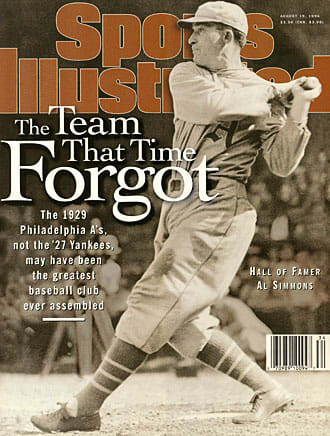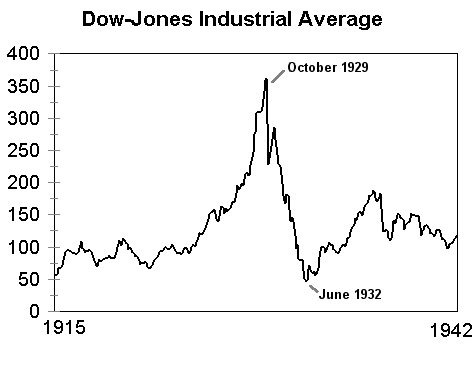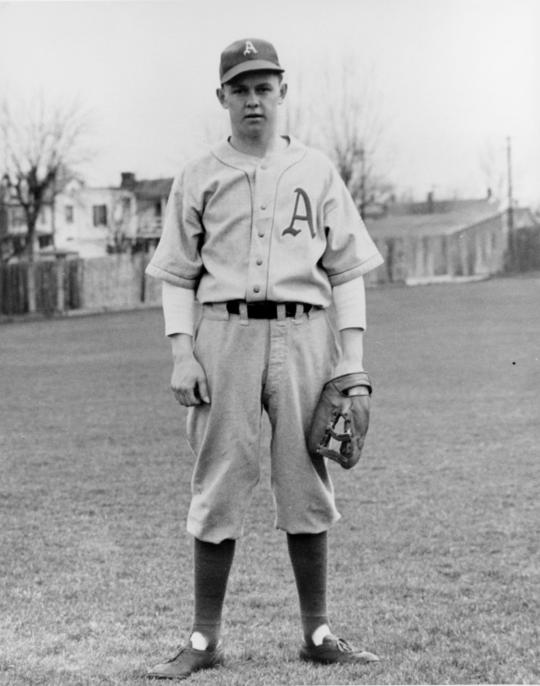Connie Mack.
The $100,000 infield.
Double X.
Charlie O. Finley.
Reggie Jackson and the Swingin' A's.
Rollie Fingers' mustache.
Rickey Henderson's speed.
The Bash Brothers.
Billy Beane's
Moneyball.
This summer, The Collector says farewell to an iconic franchise in a six-part series titled Saturdays with the A's. Next year, the franchise begins a temporary residence in Sacramento
before moving to their fifth home city, Las Vegas, for the 2028 MLB
season.
Today we'll revisit the Philadelphia years in Part I -- Mister Mack.
⚾
The Oakland Athletics are currently playing their 57th - and final - season in the Bay Area. Their stay in Philadelphia was nearly as long, lasting for 54 years until the team moved to Kansas City for the 1955 season.
The Athletics were one of eight franchises forming the American League in 1901.

Under 38 year-old manager Connie Mack, the Athletics finished fourth out of eight teams with a 74-62-1 record. The '01 team had two Hall of Famers: left-handed pitcher Eddie Plank and second baseman Napoleon "Nap" Lajoie. Let's talk about Nap for a bit.
The National League - where Lajoie began his career with the crosstown Phillies - was seen as superior to the upstart AL. Lajoie was the new league's biggest star; in 1901 he won the Triple Crown and led both leagues in hits, runs scored, on-base percentage, slugging, and batting average with a .426 mark -- a modern-day record that no one in the AL or NL has matched since.
Philadelphia improved to 83-53-1 in 1902 and won the American League pennant - one year prior to the birth of the World Series. Their star slugger was... not Nap Lajoie. His old NL squad had sued to reclaim their "property", so the "property" agreed to play for Cleveland starting that year (as a stipulation, Lajoie couldn't even play in Philadelphia as a visiting player). Nap was such a significant asset to the Cleveland squad that they named the team after him for the duration of his tenure there.
While the circumstances surrounding Lajoie's departure were unique, the Athletics losing a legendary player in his prime would be a recurring theme of the franchise's entire 124-year history.
Connie Mack's squad pressed on in the aughts, building a formidable pitching staff around Plank, eccentric lefty Rube Waddell, and Charles "Chief" Bender -- antecedents of Hudson, Mulder, and Zito.
The A's were the second AL team to play in a World Series, losing to the Giants in 1905. Pitching would be the team's bread and butter until the end of the decade, when Eddie Collins emerged.
While Collins never hit .400 in a season or won a batting title, he would eventually surpass Lajoie as the all-time leader in hits and WAR among second basemen. Collins also holds the position record for most stolen bases with 741 (8th all time), and his six World Series victories are the most of any MLB player who never played a single game for the Yankees.
The first half of the 1910s belonged to the Athletics, as the team won back-to-back World Series titles in 1910 and 1911, then added a third in '13. Mack's men posted six straight 90+ win seasons from 1909 to 1914, balancing out the stellar pitching of Plank, Bender, and Jack Coombs with a powerhouse lineup. Five of the A's eight starting fielders batted .310 or better in '11 including 20 year-old Stuffy McInnis, a 5' 9", 160-lb first baseman who compiled over 2,400 hits and 1,000 RBI in his career - but managed just 20 total home runs.
That home run total would be surpassed in just two seasons by the A's third baseman, Frank Baker, who led the AL in round-trippers each season from '11 to '14 - earning him the nickname "Home Run."
Baker combined with McInnis, Collins, and shortstop Jack Barry to form the
$100,000 infield - which doesn't sound impressive in 2024 where even John Fisher pays his players
several times that amount. But back then, it was a nickname meant to convey the infield's value to a dynasty in the making.

Philadelphia's penny-pinching owner didn't agree, and refused to raise Baker's salary for the 1915 season. He also sold Eddie Collins to the White Sox for $50,000, sold Barry to the Boston Red Sox for $10,000, and lost pitchers Plank and Bender to the brand new Federal League.
Who was that cheapskate, you ask?
 |
| Oh. |
Yes, Mr. Mack also owned the Athletics and had a direct role in roster construction. So when a rival league emerged and player salaries escalated, Mack the owner left Mack the manager little to work with. If you thought the 1997 Marlins fire sale was bad... imagine a 3x World Series winner and 4x pennant winner (let's say the Astros) selling off their top stars within a year and falling from first place to dead last in the entire AL. Now imagine that Astros team losing 56 more games than the year prior.
Despite the exodus, the '15 A's weren't completely bereft of talent. McInnis and catcher-outfielder Wally Schang were still around, and Mack brought back Nap Lajoie to replace Collins. It wasn't nearly enough. Philly's American League squad hit rock bottom a season later, winning just 36 games in 1916. (For comparison, the A's also won 36 games in 2020 - in a 60-game season.)
Astoundingly, Mack did not fire his manager after six consecutive last-place finishes, giving Mack a chance to rebuild the Athletics from the ground up. And Mack did exactly that in the 1920s, crawling back into contention slowly until 1925, when the 88-win A's finished second to Washington in the AL.
The resurgent Athletics finished second two more times in the '20s, trailing the "Murder's Row" Yankees by 19 games in 1927 and 2.5 games in 1928. Then they won the next three American League pennants and completed their rebuild with World Series titles in '29 and '30.

Connie Mack had restocked the roster with quality pitching (led by Hall of Famer Lefty Grove) and exceptional offense. Hall of Famers Mickey Cochrane and Al Simmons emerged in the mid-'20s, supported by .325 hitters Jimmy Dykes and Bing Miller. Max "Camera Eye" Bishop had a low batting average but a very high on-base percentage as he often collected more walks than hits.
But the final piece of the puzzle, the slugger who helped them leap ahead of the Ruth and Gehrig-led Yankees was a young first baseman named Jimmie Foxx.

A powerful right-handed hitter, Foxx debuted in 1925 as a 17-year old catcher. He played sparingly in '26 and '27 before earning the full-time first base job two years later. "Double X" led the AL in on-base percentage and finished top-five in batting average, slugging, OPS, home runs, and runs scored while starting a streak of twelve 30+ home run seasons.
This Athletics team was built to last, and without a rival league competing for players and driving up salaries, Mr. Mack could keep his stars well into the next decade....unless there was some major economic catastrophe crippling the country in the early 1930s.
 |
| Oh. |
Mack sold Al Simmons, Jimmy Dykes, and sacrifice hit king Mule Haas to the White Sox for $100,000 - not a complete surrender considering Dykes was on the back nine of his career and the A's had "Indian" Bob Johnson ready to replace Simmons in left field. Philadelphia finished second in 1932, third in 1933... and then Fire Sale III occurred.
With the United States experiencing nearly 25% unemployment in late 1933, baseball tickets became a luxury few could afford. As revenues sank, team owners like Mr. Mack were forced to slash expenses. As a result, Lefty Grove and Max Bishop were sold to the Red Sox, while Mickey Cochrane was traded to the Tigers for a far less accomplished catcher and $100,000 cash.

Spare a thought for poor Bob Johnson, who finally made the big club as a 27 year-old in '33, only to watch nearly all of the surrounding stars sold or traded away. He remained with the A's until 1942, enduring eight consecutive 90-loss seasons as the A's floundered at or near the bottom of the AL. After a year with the second-place Senators, Johnson concluded his career with the Red Sox as a placeholder while Ted Williams served his country in World War II. Johnson's retirement after the 1945 season coincided with Ted's return; Boston won the pennant in 1946.
Connie Mack would continue to manage the Athletics through the post-war years of the 1940s, but there would be no Mini-Dynasty III. In the twenty seasons from 1935 to 1954 - their final year in Philly - the Athletics would post a winning record twice: 1948 and 1949.
 |
TIL Nellie “single X” Fox began his career with the A's
|
Connie Mack was still managing the team at 86 years old (take that, Tony LaRussa). He had somehow squeezed 81 wins out of a team with Alex Kellner as the "ace" of the pitching staff, and an offense led by Eddie Joost, Elmer Valo and Sam Chapman. He managed one more season - a disastrous 1950 campaign that saw the A's drop back to the basement - and then passed the baton to his former third baseman Jimmy Dykes. Mack had given the franchise absolutely everything he had.
As an acknowledgement of a half-century of service, Shibe Park was renamed Connie Mack Stadium in his honor. The team would soon leave the 45 year-old park and head west...
⚾
We'll follow the team to their second home in the second installment of Saturdays with the A's. I hope you'll join me for The Kansas City AAA's next month.
Thanks for reading!
~










:format(webp)/cdn.vox-cdn.com/uploads/chorus_image/image/67616071/1279233560.jpg.0.jpg)




.jpg)



